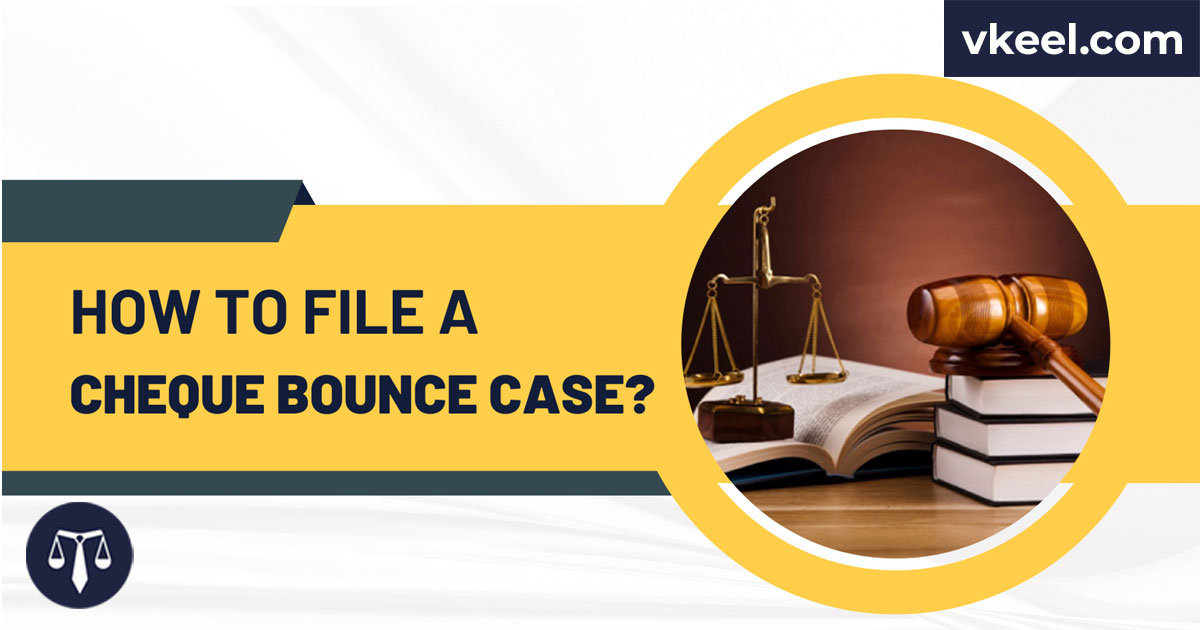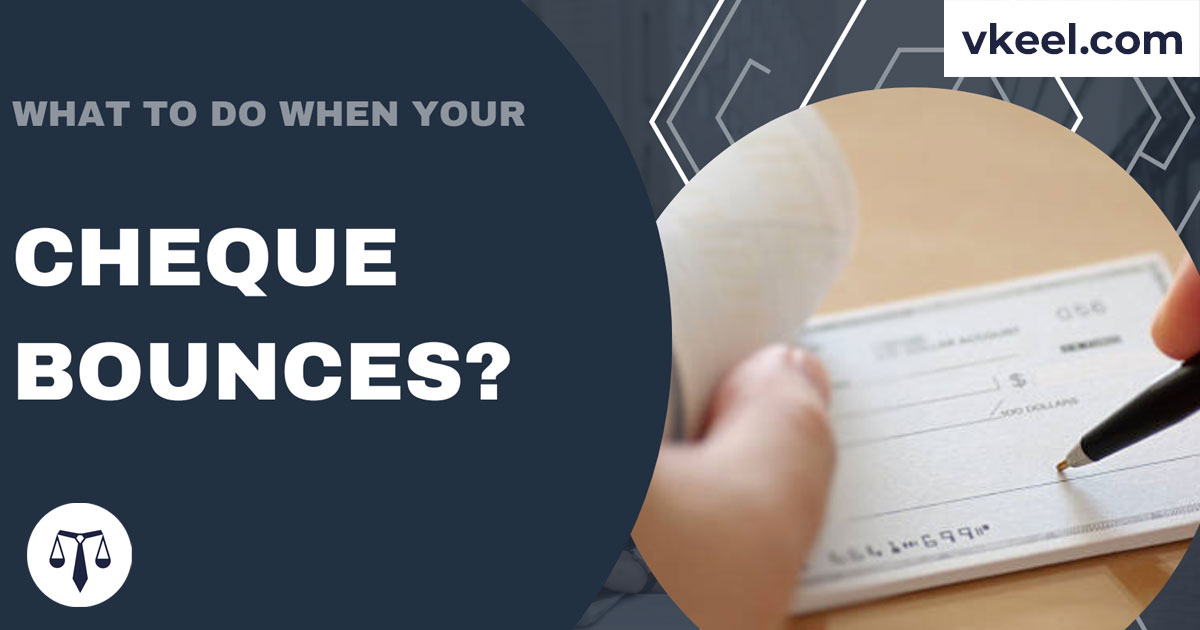How to File a Cheque Bounce Case?
By Vkeel Team
Table of Contents
- Introduction
- What is a Cheque Bounce Case and How to File it?
- What are the Different Types of Cheque Bounce?
- What is the Procedure to File a Cheque Bounce Case?
- What are the Common Mistakes to Avoid When Filing a Cheque Bounce Case?
- What are the Rights of the Defendant/ Complainant in a Cheque Bounce Case?
- What are the Time Limits for Filing a Cheque Bounce Case?
- What are the Documents Required to File a Cheque Bounce Case?
- Benefits of hiring a Lawyer for Cheque Bounce Case
- Conclusion
Introduction
Filing a cheque bounce case is a legal process that can be used to recover money owed to you. It is important to understand the process and the legal implications of filing a cheque bounce case. This guide will provide an overview of the process, including the necessary steps to take and the legal implications of filing a cheque bounce case. It will also provide information on the documents required and the time frame for filing a cheque bounce case.
What is a Cheque Bounce Case and How to File it?
A cheque bounce case is a legal action taken against an individual or business when a cheque they have issued is returned by the bank due to insufficient funds. This is also known as a dishonoured cheque.
When a cheque is returned, the payee (the person who was supposed to receive the payment) can file a cheque bounce case against the issuer of the cheque. This is done by filing a complaint with the local police station or the court. The complaint must include the details of the cheque, the date it was issued, the amount, and the name of the issuer.
In order to file a cheque bounce case, the payee must first provide proof that the cheque was issued and that it was returned due to insufficient funds. This can be done by providing a copy of the cheque, a copy of the bank statement showing the cheque was returned, and a letter from the bank confirming the return of the cheque.
Once the complaint is filed, the court will issue a summons to the issuer of the cheque. The issuer must then appear in court and present their defence. If the court finds that the cheque was indeed returned due to insufficient funds, the issuer may be liable for damages.
It is important to note that filing a cheque bounce case is a serious matter and should not be taken lightly. If the court finds that the issuer of the cheque was negligent or fraudulent in issuing the cheque, they may be liable for criminal charges.
What are the Different Types of Cheque Bounce?
A cheque bounce is a situation in which a cheque is returned by the bank due to insufficient funds in the account of the issuer. There are several types of cheque bounce, each with its own set of consequences.
1. Insufficient Funds: This is the most common type of cheque bounce. It occurs when the issuer does not have enough money in their account to cover the amount of the cheque.
2. Account Closed: This type of cheque bounce occurs when the issuer’s account has been closed by the bank.
3. Post-Dated Cheque: This type of cheque bounce occurs when the issuer has written a cheque for a date in the future.
4. Signature Mismatch: This type of cheque bounce occurs when the signature on the cheque does not match the signature on the issuer’s bank account.
5. Alteration: This type of cheque bounce occurs when the issuer has made changes to the cheque without the knowledge of the payee.
6. Stop Payment: This type of cheque bounce occurs when the issuer has instructed the bank to stop payment on the cheque.
7. Stale Cheque: This type of cheque bounce occurs when the cheque is more than six months old.
Cheque bounce can have serious consequences for both the issuer and the payee. It is important to understand the different types of cheque bounce and take steps to avoid them.
What is the Procedure to File a Cheque Bounce Case?
Filing a cheque bounce case is a legal process that requires careful consideration and adherence to the relevant laws. The procedure for filing a cheque bounce case is as follows:
1. Obtain a copy of the bounced cheque: The first step in filing a cheque bounce case is to obtain a copy of the bounced cheque. This can be done by requesting a copy from the bank or by obtaining a copy from the issuer of the cheque.
2. File a complaint with the police: Once you have obtained a copy of the bounced cheque, you must file a complaint with the local police station. The complaint should include the details of the cheque, the date of issue, the amount, and the name of the issuer.
3. File a complaint with the court: After filing a complaint with the police, you must file a complaint with the court. The complaint should include the details of the cheque, the date of issue, the amount, and the name of the issuer.
4. Serve the notice to the issuer: Once the complaint has been filed with the court, you must serve a notice to the issuer of the cheque. The notice should include the details of the cheque, the date of issue, the amount, and the name of the issuer.
5. Attend the court hearing: After serving the notice to the issuer, you must attend the court hearing. During the hearing, the court will hear both sides of the case and decide whether or not the issuer is liable for the bounced cheque.
6. Collect the amount due: If the court finds the issuer liable for the bounced cheque, you can collect the amount due from the issuer.
Following these steps will ensure that you are able to file a successful cheque bounce case. It is important to note that the process may vary depending on the jurisdiction in which the case is being filed. Therefore, it is important to consult a lawyer to ensure that you are following the correct procedure.
What are the Common Mistakes to Avoid When Filing a Cheque Bounce Case?
When filing a cheque bounce case, it is important to be aware of the common mistakes to avoid. These include:
1. Not filing the case within the prescribed time limit: According to the Negotiable Instruments Act, a cheque bounce case must be filed within 30 days of the date of the cheque. Failing to do so may result in the case being dismissed.
2. Not providing sufficient evidence: When filing a cheque bounce case, it is important to provide sufficient evidence to prove that the cheque was dishonoured. This includes providing a copy of the cheque, the bank statement, and any other relevant documents.
3. Not following the correct procedure: It is important to follow the correct procedure when filing a cheque bounce case. This includes filing the case in the correct court, providing the necessary documents, and following the court’s instructions.
4. Not seeking legal advice: It is advisable to seek legal advice before filing a cheque bounce case. This will ensure that the case is filed correctly and that all the necessary documents are provided.
By avoiding these common mistakes, it is possible to ensure that the cheque bounce case is filed correctly and that the desired outcome is achieved.
What are the Rights of the Defendant/ Complainant in a Cheque Bounce Case?
In a cheque bounce case, both the defendant and the complainant have certain rights that must be respected.
The defendant has the right to be informed of the complaint against them and to be given the opportunity to respond to the complaint. They also have the right to be represented by a lawyer and to present evidence in their defense.
The complainant has the right to present evidence in support of their claim and to be heard in court. They also have the right to receive a fair and impartial hearing and to be informed of the outcome of the case.
Both parties also have the right to appeal the decision of the court if they are not satisfied with the outcome. It is important to note that the rights of both parties must be respected throughout the process.
What are the Time Limits for Filing a Cheque Bounce Case?
Under the Negotiable Instruments Act, 1881, a cheque bounce case must be filed within 30 days of the date of the dishonoured cheque. This time limit is applicable to both civil and criminal cases.
In civil cases, the limitation period is 30 days from the date of the dishonoured cheque. The limitation period for criminal cases is also 30 days from the date of the dishonoured cheque.
It is important to note that the limitation period for filing a cheque bounce case is not extended even if the drawer of the cheque has made a payment or has promised to make a payment.
It is also important to note that the limitation period for filing a cheque bounce case can be extended in certain circumstances. For example, if the drawer of the cheque has made a payment or has promised to make a payment, the limitation period can be extended by up to 90 days.
It is therefore important to file a cheque bounce case within the prescribed time limit in order to ensure that the case is heard in a timely manner.
What are the Documents Required to File a Cheque Bounce Case?
Filing a cheque bounce case requires certain documents to be submitted to the court. These documents are necessary to prove the validity of the case and to ensure that the proceedings are conducted in a fair and just manner. The documents required to file a cheque bounce case are as follows:
1. A copy of the cheque that has been dishonoured by the bank.
2. A copy of the notice sent by the bank to the drawer of the cheque informing them of the dishonour.
3. A copy of the demand notice sent by the payee to the drawer of the cheque.
4. A copy of the acknowledgement of the demand notice sent by the drawer of the cheque.
5. A copy of the complaint filed by the payee in the court.
6. A copy of the summons issued by the court to the drawer of the cheque.
7. A copy of the reply filed by the drawer of the cheque in the court.
8. Any other documents that may be relevant to the case.
These documents are necessary to prove the validity of the case and to ensure that the proceedings are conducted in a fair and just manner. It is important to ensure that all the documents are in order before filing a cheque bounce case in the court.
Benefits of hiring a Lawyer for Cheque Bounce Case
Hiring a lawyer for a cheque bounce case is a wise decision as it can help you to protect your rights and interests. A lawyer can provide you with the legal advice and representation you need to ensure that your case is handled properly. Here are some of the benefits of hiring a lawyer for a cheque bounce case:
1. Knowledge of the Law: A lawyer is well-versed in the laws related to cheque bounce cases and can provide you with the best legal advice. They can help you understand the legal implications of the case and guide you through the process.
2. Representation in Court: A lawyer can represent you in court and ensure that your rights are protected. They can also help you to prepare for the case and present your case in the best possible way.
3. Negotiation Skills: A lawyer can help you to negotiate with the other party and reach an amicable settlement. They can also help you to understand the legal implications of the settlement and ensure that it is in your best interests.
4. Timely Resolution: A lawyer can help you to resolve the case in a timely manner. They can help you to understand the legal process and ensure that the case is handled efficiently.
Overall, hiring a lawyer for a cheque bounce case can be beneficial as they can provide you with the legal advice and representation you need to ensure that your rights are protected. They can also help you to negotiate with the other party and reach an amicable settlement.
Conclusion
Filing a cheque bounce case is a complex process that requires careful consideration and preparation. It is important to understand the legal implications of filing a case and to be aware of the applicable laws and regulations. It is also important to be aware of the time limits for filing a case and to ensure that all the necessary documents are in order. With the right preparation and understanding of the process, filing a cheque bounce case can be a successful endeavor.
Disclaimer:
The information provided in the article is for general informational purposes only, and is not intended to constitute legal advice or to be relied upon as a substitute for legal advice. Furthermore, any information contained in the article is not guaranteed to be current, complete or accurate. If you require legal advice or representation, you should contact an attorney or law firm directly. We are not responsible for any damages resulting from any reliance on the content of this website.






